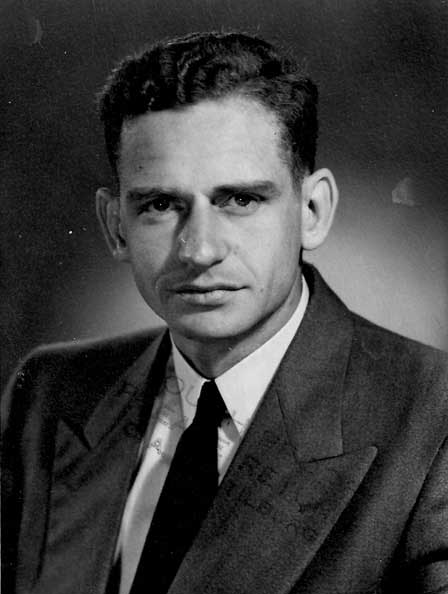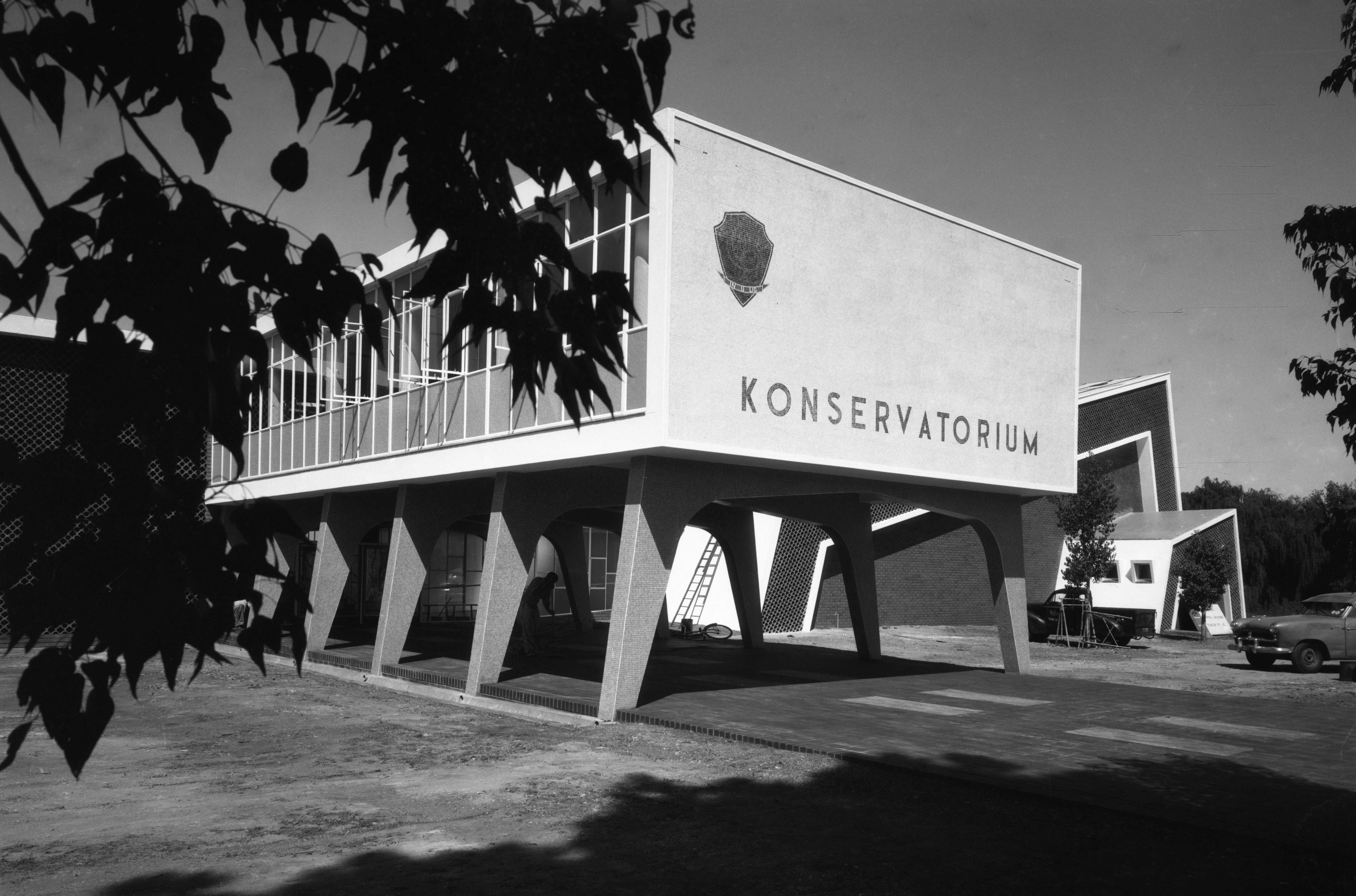Conservatory (K1)
- The music history of Potchefstroom started almost a century before the Conservatory was built. The first music recital, of which we have a record, was on 9 August 1863 when a group by the name De Harmonie held a concert and had an ambitious 21 items on the programme.
- In the years that followed various musical societies and teachers were active in Potchefstroom. In 1914 MM van der Bent and his wife, Florence, founded the Potchefstroom College of Music, which was situated in a building in Potgieter Street (currently Nelson Mandela Drive).
When the Potchefstroom University College (PUC) bought this music school in 1949, it was regarded as one of the most important music institutions in the Transvaal.

Photo: About 1950
- The PUC made music lessons available earlier in the forties. By 1945 the Department of Music was founded and Music was accredited as one of the main subjects for a BA degree. The permanent lecturer was Mr Jacques Malan.
- The active interest that the Potchefstroom community had in music, was one of the reasons which convinced the PUC to create the Academy for Practical Music (Konservatorium vir Praktiese Musiek) where students could receive instruction in music. The first head was the much sought-after organist, MC (Maarten) Roode, who, amongst other accomplishments, was the official organist during the official opening of the Voortrekker Monument. Roode assumed duty at the PUC in July 1949.
- When instruction at the Conservatory started in 1950, there were 307 pupils, taught by 14 music teachers. Under the capable leadership of Roode, the Conservatory grew constantly. The Conservatory and Department of Music initially existed apart from each other until 1955, but after the departure of Dr Jacques Malan, they were amalgamated.
- Roode became a professor in 1955 and with the amalgamation in 1956, also became head of the Department of Music. He died at the age of sixty in 1967 after a car accident in Potchefstroom, during which his wife also passed away.
- The first building to be used for music instruction, was the old mill on the Oude Molen grounds, where the Conservatory stands today. With the growth in student numbers facilities were used all over town, amongst others the old Theological School, rooms in nearby schools and a rented house.
- Plans to build the Conservatory were already made in 1952 and in order to do so universities overseas were consulted.
- After serious consideration, it was decided to build it on the Oude Molen grounds since the increase in traffic with recitals could only be dealt with there.
- The architect for the Conservatory was Johan de Ridder, which had a difficult task on his hands. Only £75 000 was available, whilst the initial costs was calculated at £912 100. Subsequently the plans had to be considerably scaled down. Afterwards the plans made provision for an auditorium with 1 200 seats, 20 small practice rooms, 12 studios, four classrooms and a library, which also had to serve as a discotheque, two organ practice rooms, a storage room for instruments, three offices, a staff room, kitchen, cloakrooms and toilet facilities. The total cost was £70 610, which excluded air-conditioning and fittings and was thus still too much.
- After further consultation, the orchestra pit was excluded from the auditorium and it was down-sized to 350 seats. The final building costs were £78 000.
- The organ that was initially installed in the auditorium of the Conservatory was built by a local firm, R Müller & Son and was designed by the head of the Conservatory, Prof MC Roode, himself. This organ was later, due to technical and artistic deficiencies, not used anymore. It was removed in 1992 and installed in the Reformed Church Wapadrant in Pretoria.
- The inauguration of the Conservatory was a big and important event for the University. The official inauguration was on 8 April 1960 and was performed by the Chancellor of University, Dr FJ (Frans) du Toit. Six concerts were presented early in May 1960 as part of the inauguration programme.
- One of those was a concert by the composer, Arnold van Wyk, in a programme that existed only of his works. The SABC Concert Orchestra, under the baton of Anton Hartman, also held a concert.
- The Conservatory was then described as the most modern in the Union of South Africa and the Potchefstroom University was the first university in the country to have its own conservatory building.
- In 1963 a further hall was built at the back of the building and in 1974 the organ auditorium and new library/discotheque was added as part of a three storey wing.
- Currently the Conservatory houses the School of Music as the old Department of Music is known since 2003.
- Facilities at the Conservatory include the Conservatory Hall or auditorium with 372 seats, whereas the organ auditorium with its baroque organ has 100 seats.
- The Pretorius Music Studio houses several antique pieces, including valuable South African art and has seating for 80. Apart from the music library, there are also two lecture halls, a few studios, about 30 practice rooms, all mainly equipped with pianos, as well as two practice organs.
Prof MC Roode
He was from 1949 until his death after a car accident in 1967 a member of the staff of the PU. He was the first head of the Conservatory

Herald 29 April 1960
The Potchefstroom Herald gave wide coverage about the inauguration of the Conservatory in 1960. This photo page was published on 29 April 1960 and shows some of the artists who performed during some of the inaugural concerts.
In the top right-hand corner is Pieter de Villiers, who assisted composer Arnold van Wyk in a performance of a work for four hands.
Bottom left is Arnold van Wyk. One of the six inaugural concerts was devoted to his works.
Top middle is the soprano Betsie de la Porte, who was to be accompanied by Arnold van Wyk.
Bottom middle is Anton Hartman, conductor of the SABC Concert Orchestra, who was to perform in another concert.

Architect of the Conservatory: Johan de Ridder (1927-2013)
Photo: artefacts.co.za
Architect Johan de Ridder designed the Conservatory. On the NWU campus, he also designed the Zoology building,
the Physiology building, the Pharmacy Building and the Psychology building.
When the President Pretorius Museum was restored in the late 1970s, he was the restoration architect. He also designed the church building of the Reformed Church, Potchefstroom.

This artist’s impression depicts how the Conservatory looked after it was completed in 1960.
The artist is CMA Hattingh and the architect of the Conservatory was Johan de Ridder.

Photo: about 1960

Photo: about 1989
